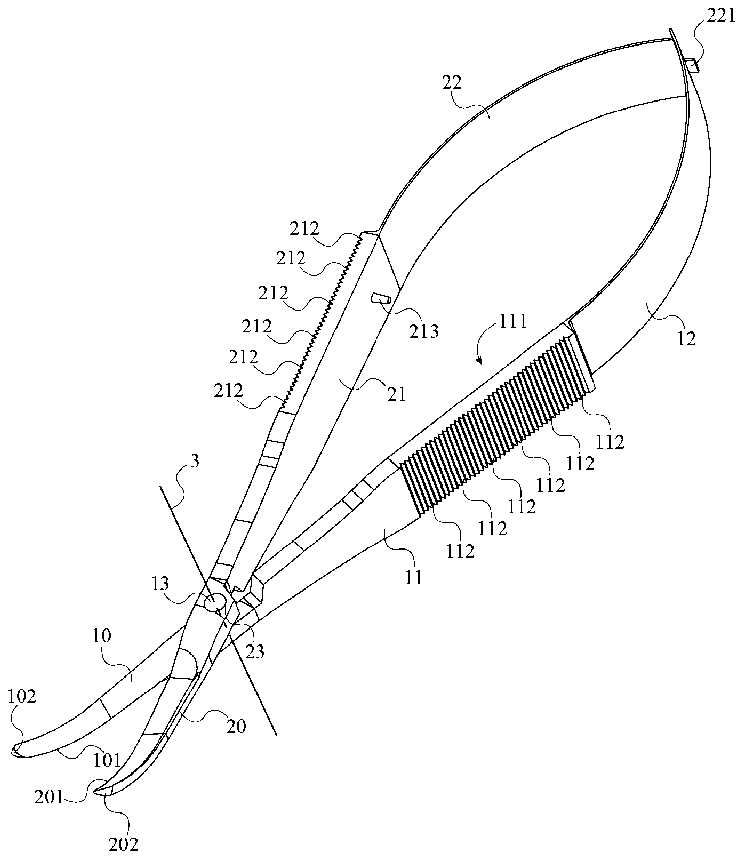
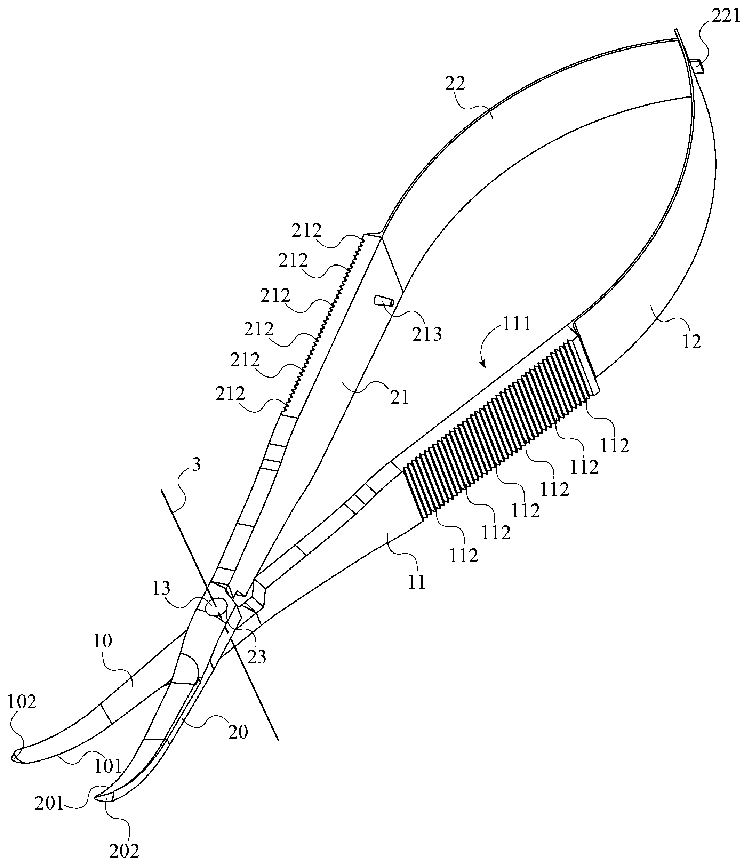
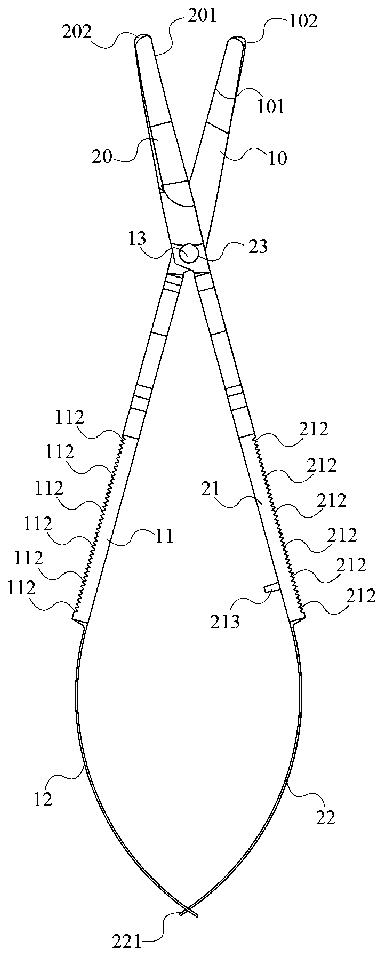


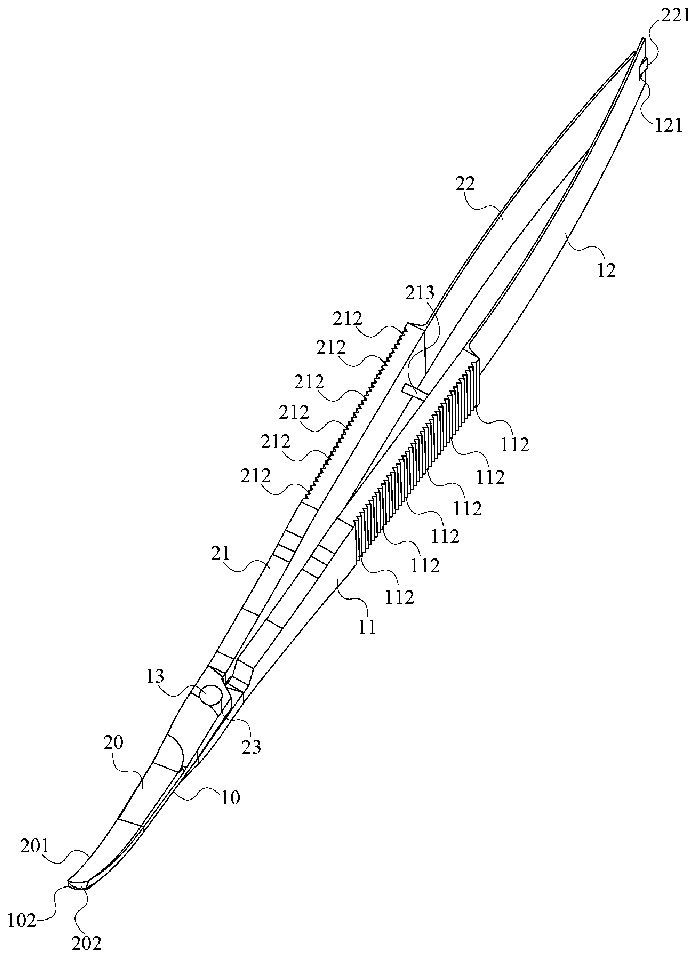

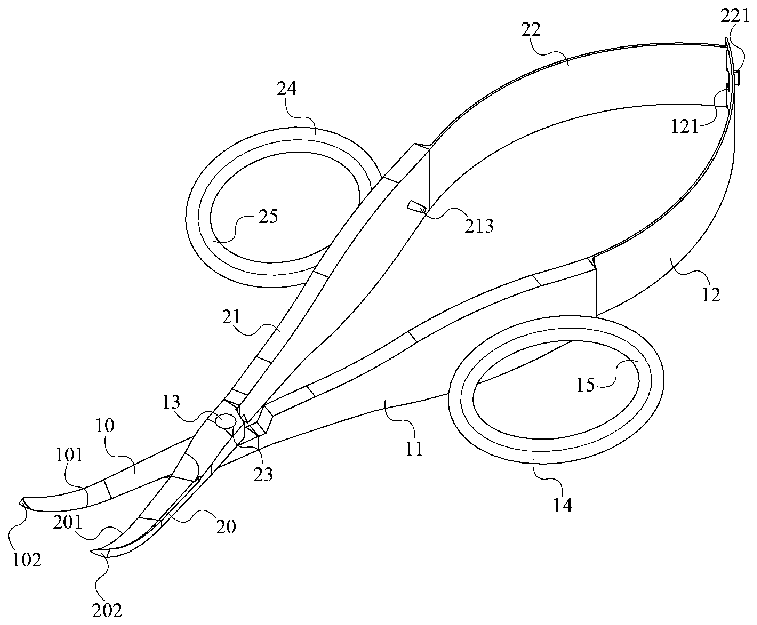
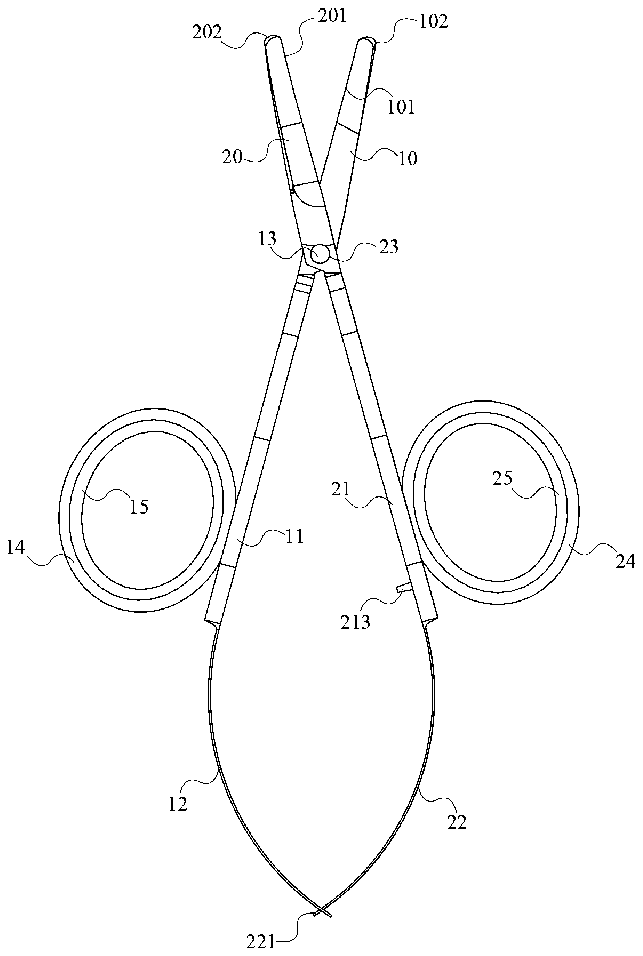


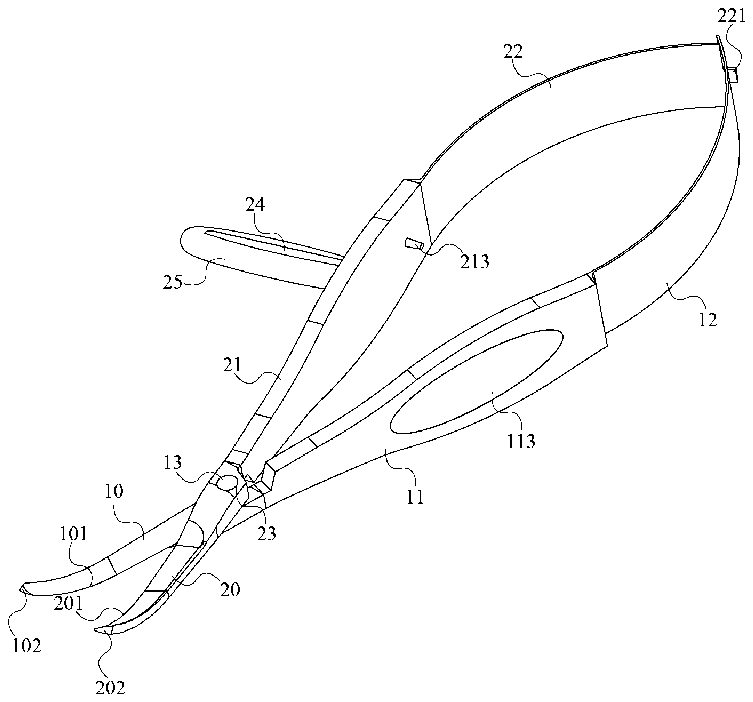
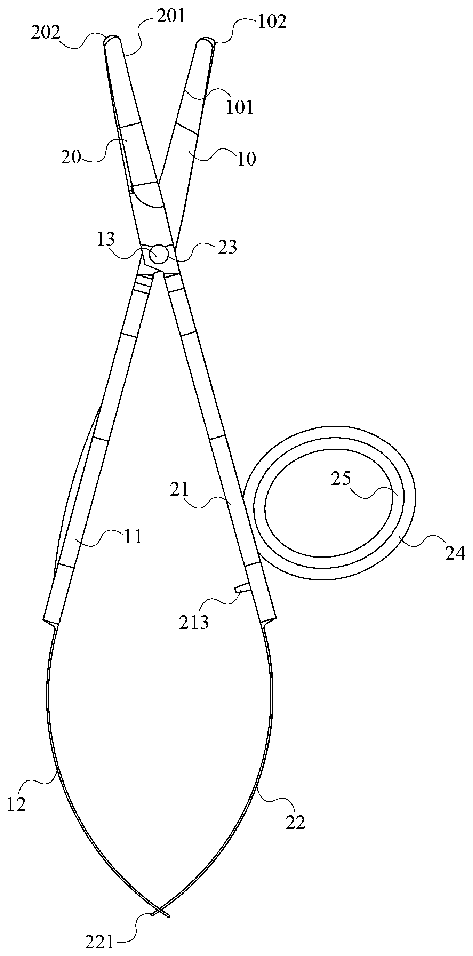


- 1first arm
- 2second arm
- 3hinge axis
- 10first blade
- 11first handle
- 12first spring
- 13hinge
- 14first loop
- 15first grip
- 20second blade
- 21second handle
- 22second spring
- 23hinge hole
- 24second loop
- 25second grip
- 101first cutting edge
- 102first blunt end
- 103mid-curve
- 104mid-plane
- 111first grip area
- 112gripping grooves
- 113grip pad
- 121spring notch
- 201second cutting edge
- 202second blunt end
- 203mid-curve
- 204mid-plane
- 211second grip area
- 212gripping grooves
- 213stop
- 221spring tab
Abstract
A baby safe trimming tool has a first blade and a second blade being curved as to accommodate the curved nature of human nails. The first blade is connected to a first handle opposite a first spring. The second blade is connected to a second handle opposite a second spring, and is pivotally connected to the first blade, wherein a first cutting edge of the first blade is scissionably aligned with a second cutting edge of the second blade. The first spring engages the second spring to provide a restoring force when the first handle and the second handle are squeezed together. The first handle and the second handle can be outfitted in multiple grip configurations in order to provide enhanced comfort and grip for a user, wherein a grooved grip area or a loop may be provided for either the first handle or the second handle.
Description
[0001] The current application claims a priority to the U.S. Provisional Patent application Ser. No. 61/818,938 filed on May 3, 2013.
FIELD OF THE INVENTION
[0002] The present invention relates generally to a shearing apparatus. More specifically, the present invention is a baby safe trimming tool that is designed to allow a user to safely trim the fingernails and toenails of a baby with minimal risk of the user inflicting injury on the baby.
BACKGROUND OF THE INVENTION
[0003] Personal hygiene is a very important part of modern society. There are many components that combine to make up the general term of personal hygiene. Some examples of actions which fall within the realm of personal hygiene include, but are not limited to, brushing teeth, flossing, showering, washing hands, and trimming nails. The trimming of nails may not seem to be linked to personal hygiene, but it is indeed very important to personal hygiene for at least one reason. Longer nails can promote the collection of dirt and grime underneath the nail, and such dirt and grime can be difficult to remove from under the nail. Additionally, long nails can cause some problems. For example, long fingernails can easily scratch other people. Combine this with the aforementioned accumulation of dirt and grime under the nail, and it is not impossible for a person to sustain a scratch wound which can become infected. Long toenails can be an issue as they may become caught on the interior of socks. The toenail can potentially damage the sock or break off and cause a painful hangnail. Therefore, it is important to maintain shorter fingernails and toenails to ensure that none of the issues described above are experienced.
[0004] There are many ways by which a person can trim their nails. The most common method is through the use of a specially designed nail clipper. It is important to use a nail clipper as opposed to simply using a standard pair of scissors. Although it is possible to trim nails using a standard pair of scissors, however this method is highly risky because of the composition of human nails and their proximity to soft flesh. Human nails are comprised of a hard protein substance known as keratin, which can easily cause a standard pair of scissors to slip during cutting, thereby potentially injuring the owner of the nails. It is also possible for a person to trim their nails by using their teeth, however this method is widely considered to be uncivilized and is indeed not very hygienic as the human mouth harbors a wealth of infectious bacteria.
[0005] There are many different types of nail clippers available on the market, however they are all designed for the same task, to trim the nail efficiently and with minimal risk of injuring the user. All currently available nail clippers are efficient at trimming nails, and are indeed quite safe when a user trims their own nails using them. However, it is very easy for the user to injure another person whose nails they are trimming. This is of particular importance for children and babies who are incapable of trimming their own nails and require a parent to perform this task for them. It can be very easy for the parent to accidentally injure their child when using one of the currently available designs of nail clippers; this is very stressful for all parties involved as the parent is upset over causing their child pain, and the child is upset over being in pain. It is clear that there is significant room for improvement in the field of nail trimming apparatuses.
[0006] Therefore, it is an object of the present invention to introduce a baby safe trimming tool that allows a user to trim the nails of another person with reduced risk of injuring the person whose nails are being trimmed. The present invention accomplishes this through a the unique design of the blades and handle. It is a further object of the present invention to be small and nimble enough such that it can be easily used to trim the smaller nails of a human child.
BRIEF DESCRIPTION OF THE DRAWINGS
[0007] FIG. 1 is a perspective view of the present invention in a first grip configuration and in an open configuration.
[0008] FIG. 2 is a top plan view of the present invention in the first grip configuration.
[0009] FIG. 3 is a right side elevational view of the present invention in the first grip configuration.
[0010] FIG. 4 is a left side elevational view of the present invention is the first grip configuration.
[0011] FIG. 5 is a diagram depicting the mid-curve of the first blade being coplanar with the hinge axis about the mid-plane of the first blade.
[0012] FIG. 6 is a diagram depicting the mid-curve of the second blade being coplanar with the hinge axis about the mid-plane of the second blade.
[0013] FIG. 7 is a perspective view of the present invention in the first grip configuration and in a closed configuration.
[0014] FIG. 8 is a top plan view of the present invention in the closed configuration.
[0015] FIG. 9 is a perspective view of the present invention in a second grip configuration and in an open configuration.
[0016] FIG. 10 is a top plan view of the present invention in the second grip configuration.
[0017] FIG. 11 is a right side elevational view of the present invention in the second grip configuration.
[0018] FIG. 12 is a left side elevational view of the present invention is the second grip configuration.
[0019] FIG. 13 is a perspective view of the present invention in a third grip configuration and in an open configuration.
[0020] FIG. 14 is a top plan view of the present invention in the third grip configuration.
[0021] FIG. 15 is a right side elevational view of the present invention in the third grip configuration.
[0022] FIG. 16 is a left side elevational view of the present invention is the third grip configuration.
DETAIL DESCRIPTIONS OF THE INVENTION
[0023] All illustrations of the drawings are for the purpose of describing selected versions of the present invention and are not intended to limit the scope of the present invention.
[0024] The present invention is a baby safe trimming tool that allows a user to safely trim the fingernail and a toenails of a baby. While the present invention is intended for use with babies, the baby safe trimming tool can be used on people of any age. The baby safe trimming tool comprises a first arm 1 and a second arm 2 that are pivotally connected to each other. By manipulating the first arm 1 in relation to the second arm 2 , or vice versa, the present invention produces a shearing force that is used to cut through the fingernails or toenails of an individual.
[0025] In reference to FIG. 1 , the first arm 1 comprises a first blade 10 , a hinge 13 , a first handle 11 , and a first spring 12 . The first arm 1 may be constructed from any number of different materials, however, metal is the most appropriate choice and is the material used in the preferred embodiment of the present invention. The first blade 10 is thin and has a slight curve as can be seen in FIG. 1 , and is adjacently connected to the first handle 11 . Furthermore, the first blade 10 comprises a first blunt end 102 and a first cutting edge 101 . The first cutting edge 101 is positioned along the first blade 10 and is a sharpened edge that allows the first blade 10 to slice through the tough keratin of human nails. The slight curve is present because most human nails have a natural curve at the terminating end of each of the nails. By matching the curve of the first blade 10 to the curve at the terminating end of the nails as closely as possible, the cutting efficiency of the present invention is maximized.
[0026] In reference to FIG. 2-3 , the first blunt end 102 is positioned on the first blade 10 opposite the first handle 11 and prevents the first blade 10 from being used in a stabbing manner. The first blunt end 102 of the first blade 10 is rounded such that there is no sharp point that is capable of piercing human flesh. As babies move around quite often, there is the opportunity for the user to miscalculate maneuvering the present invention. In such an instance, the first blunt end 102 would prevent the baby from being stabbed by the present invention.
[0027] In reference to FIG. 1-2 , the hinge 13 provides a point of connection between the first arm 1 and the second arm 2 . Furthermore, the hinge 13 connects the first arm 1 and the second arm 2 in a way such that the first arm 1 and the second arm 2 are allowed to rotate relative to one another, as depicted in FIG. 7-8 . The hinge 13 may be formed by a small pin, rod, rivet, fastener, etc. The hinge 13 is perpendicularly connected to the first blade 10 , wherein a hinge axis 3 traverses along the hinge 13 , and the hinge 13 is positioned adjacent to the first handle 11 . The end of the first blade 10 opposite the first handle 11 is curved towards the hinge axis 3 , such that a mid-curve 103 of the first blade 10 is coplanar with the hinge axis 3 , wherein the mid-curve 103 is coplanar with a mid-plane 104 of the first blade 10 , as depicted in FIG. 5 . In the preferred embodiment of the present invention, a hinge 13 cavity is positioned into the first blade 10 section, adjacent to the first handle 11 . The hinge 13 cavity is a circular hole which is drilled into the material of the first arm 1 . The hinge 13 is positioned into and connected to the first blade 10 via the hinge 13 cavity.
[0028] In reference to FIG. 2 , the first handle 11 section is adjacently connected to the first blade 10 just after the hinge 13 . The first handle 11 is tapered towards the first blade 10 , such that the end of the first handle 11 opposite the first blade 10 is substantially wider than the end of the first handle 11 adjacent to the first blade 10 , as to provide sufficient surface area for gripping and squeezing the first handle 11 . The width of the first handle 11 is large enough such that the user can comfortably apply force to the first handle 11 , and such that the present invention is sufficiently stable while being operated by the user. In reference to FIG. 2-3 , the first spring 12 is adjacently connected to the first handle 11 opposite the first blade 10 . The first spring 12 is constructed from a much thinner piece of material relative to the first handle 11 section. Additionally, the first spring 12 is thin enough such that the first spring 12 is able to elastically deform from the application of small amounts of force. When a force is applied to the first arm 1 through the first handle 11 , the force acts to deform the first spring 12 . As the first spring 12 is deformed, energy is stored within the first spring 12 , and when the force is removed from the first arm 1 , the energy is released, thus returning the first spring 12 to the original shape of the first spring 12 .
[0029] In reference to FIG. 1 , the second arm 2 comprises a second blade 20 , a hinge hole 23 , a second handle 21 , and a second spring 22 . The second arm 2 may be constructed from any number of different materials, however, metal is the most appropriate choice and is the material used in the preferred embodiment of the present invention. The second blade 20 is thin and has a slight curve as can be seen in FIG. 1 , and is adjacently connected to the second handle 21 . Furthermore, the second blade 20 comprises a second blunt end 202 and a second cutting edge 201 . The second cutting edge 201 is positioned along the second blade 20 and is a sharpened edge that allows the second blade 20 to slice through the tough keratin of human nails. The slight curve is present because most human nails have a natural curve at the terminating end of each of the nails. By matching the curve of the second blade 20 to the curve at the terminating end of the nails as closely as possible, the cutting efficiency of the present invention is maximized.
[0030] In reference to FIG. 2 and FIG. 4 , the second blunt end 202 is positioned on the second blade 20 opposite the second handle 21 and prevents the second blade 20 from being used in a stabbing manner. The second blunt end 202 of the second blade 20 is rounded such that there is no sharp point that is capable of piercing human flesh. As babies move around quite often, there is the opportunity for the user to miscalculate maneuvering the present invention. In such an instance, the second blunt end 202 would prevent the baby from being stabbed by the present invention.
[0031] In reference to FIG. 1-2 , the hinge hole 23 provides a point of connection between the first arm 1 and the second arm 2 . Furthermore, the hinge 13 connects the first arm 1 and the second arm 2 in a way such that the first arm 1 and the second arm 2 are allowed to rotate relative to one another, as depicted in FIG. 7-8 . The hinge hole 23 traverses through the second blade 20 and is positioned adjacent to the second handle 21 . The end of the second blade 20 opposite the second handle 21 is curved towards the hinge axis 3 running through the hinge 13 , such that a mid-curve 203 of the second blade 20 is coplanar with the hinge axis 3 , wherein the mid-curve 203 of the second blade 20 is coplanar with a mid-plane 204 of the second blade 20 . The hinge 13 is positioned through the hinge hole 23 , wherein the second arm 2 is pivotally connected to the hinge 13 and the first curved blade and the second curved blade are scissionably aligned. More specifically, the first cutting edge 101 and the second cutting edge 201 are scissionably aligned.
[0032] In reference to FIG. 2 , the second handle 21 section is adjacently connected to the second blade 20 just after the hinge hole 23 . The second handle 21 is tapered towards the second blade 20 , such that the end of the second handle 21 opposite the second blade 20 is substantially wider than the end of the second handle 21 adjacent to the second blade 20 , as to provide sufficient surface area for gripping and squeezing the second handle 21 . The width of the second handle 21 is large enough such that the user can comfortably apply force to the second handle 21 , and such that the present invention is sufficiently stable while being operated by the user.
[0033] In reference to FIG. 2 and FIG. 4 , the second spring 22 is adjacently connected to the second handle 21 opposite the second blade 20 . The second spring 22 is constructed from a much thinner piece of material relative to the second handle 21 section.
[0034] Additionally, the second spring 22 is thin enough such that the second spring 22 is able to elastically deform from the application of small amounts of force. When a force is applied to the second arm 2 through the second handle 21 , the force acts to deform the second spring 22 . As the second spring 22 is deformed, energy is stored within the second spring 22 , and when the force is removed from the second arm 2 , the energy is released, thus returning the second spring 22 to the original shape of the second spring 22 .
[0035] The first spring 12 engages the second spring 22 opposite the first handle 11 and the second handle 21 , such that when a force is applied to either the first arm 1 or the second arm 2 , both the first spring 12 and the second spring 22 deform. In reference to
[0036] FIG. 3 , the first spring 12 comprises a spring notch 121 , while the second spring 22 comprises a spring tab 221 . The spring tab 221 is positioned on the second spring 22 opposite the second handle 21 , wherein the spring tab 221 has a smaller width than the remainder of the second spring 22 . The spring notch 121 is positioned through the first spring 12 opposite the first handle 11 , and provides an opening with a width slightly larger than the width of the spring tab 221 . The spring tab 221 engages the spring notch 121 , wherein the spring tab 221 traverses through the spring notch 121 , thus securely engaging the first spring 12 to the second spring 22 .
[0037] The present invention is operable between an open configuration, as shown in FIG. 1 , and a closed configuration, as shown in FIG. 7 , wherein the open configuration is achieved by applying zero force to either the first handle 11 or the second handle 21 . In the open configuration, the first blade 10 and the second blade 20 are positioned adjacent to each other, such that there is a gap between the first cutting edge 101 and the second cutting edge 201 for positioning the material to be cut. Both the first spring 12 and the second spring 22 are in the original, non-deformed shape, and engage each other such that the first arm 1 and the second arm 2 cannot freely pivot about the hinge axis 3 .
[0038] The closed configuration is achieved by applying a force to the first handle 11 or second handle 21 in order to overcome the spring force of the first spring 12 and the second spring 22 . As the force is applied by the user, the first spring 12 and the second spring 22 collapse, allowing the first arm 1 and the second arm 2 to pivot about the hinge axis 3 . As the first arm 1 and second arm 2 pivot, the first cutting edge 101 and the second cutting edge 201 progressively engage each other, producing a shear force to cut material positioned in the gap between the first blade 10 and the second blade 20 . The closed configuration is reached when the first blade 10 and the second blade 20 completely overlap each other, wherein the first blade 10 and the second blade 20 are flush with one another. At this point, the material positioned in the gap between the first blade 10 and the second blade 20 will be fully cut along the length of the first cutting edge 101 and the second cutting edge 201 .
[0039] In reference to FIG. 2 , the second handle 21 comprises a stop 213 . The stop 213 is positioned in between the first handle 11 and the second handle 21 , and is positioned adjacent to the second spring 22 . The stop 213 is a protrusion that extends out from the second handle 21 towards the first handle 11 . When in the closed configuration, the end of the stop 213 opposite the second handle 21 engages the first handle 11 , as shown in FIG. 8 , thus preventing the first arm 1 and the second arm 2 from pivoting any further.
[0040] The present invention can be constructed with a number of grip configurations. In reference to FIG. 1-4 , in a first grip configuration, the first handle 11 comprises a first grip area 111 and a first plurality of gripping grooves 112 , while the second handle 21 comprises a second grip area 211 and a second plurality of gripping grooves 212 . The first grip area 111 is positioned on the first handle 11 opposite the second handle 21 and provides a surface of the first handle 11 for the user to grip the first arm 1 . Similarly, the second grip area 211 is positioned on the second handle 21 opposite the first handle 11 and provides a surface of the second handle 21 for the user to grip the second arm 2 . The first plurality of gripping grooves 112 is positioned across the first handle 11 about the first grip area 111 , while the second plurality of gripping grooves 212 is positioned across the second handle 21 about the second grip area 211 . The first plurality of gripping grooves 112 and the second plurality of gripping grooves 212 provide the first grip area 111 and the second grip area 211 , respectively, with an irregular surface. The irregular surface of the first handle 11 and the second handle 21 enhances the user's grip as compared to a smooth surface, thus reducing or eliminating the possibility of the present invention slipping from the user's hand while being used.
[0041] In reference to FIG. 9-12 , in a second grip configuration, the first arm 1 further comprises a first loop 14 , while the second arm 2 further comprises a second loop 24 . The first loop 14 is adjacently connected to the first handle 11 opposite the second handle 21 , such that the user may insert a thumb or finger(s) through the first loop 14 when gripping the first handle 11 ; wherein the opening through the first loop 14 is directed across the first handle 11 . Similarly, the second loop 24 is adjacently connected to the second handle 21 opposite the first handle 11 , such that the user may insert a thumb or finger(s) through the second loop 24 when gripping the second handle 21 ; wherein the opening through the second loop 24 is directed across the second handle 21 . The first loop 14 is positioned on the first handle 11 adjacent to the first spring 12 , while the second loop 24 is positioned on the second handle 21 adjacent to the second spring 22 . In this way, less force can be exerted by the user in order to operate the present invention.
[0042] In the second grip configuration, the first arm 1 may also further comprise a first grip 15 and the second arm 2 may also further comprise a second grip 25 , as depicted in FIG. 9-10 . The first grip 15 is positioned within the first loop 14 and is perimetrically connected to the first loop 14 . Similarly, the second grip 25 is positioned within the second loop 24 and is perimetrically connected to the second loop 24 . The first grip 15 and the second grip 25 act to enhance both the comfort of the present invention and the grip of the user, when the user's thumb and finger(s) are positioned through the first loop 14 and the second loop 24 . Preferably the first grip 15 and the second grip 25 are constructed from a rubber material, however, it is possible for the first grip 15 and the second grip 25 to be constructed from any grip enhancing material. In reference to FIG. 13-16 , in a third grip configuration, the second arm 2 further comprises a second loop 24 , while the first handle 11 comprises a grip pad 113 and a first plurality of gripping grooves 112 . The second loop 24 is pivotally connected to the second handle 21 opposite the first handle 11 , wherein the second loop 24 can be rotated three hundred sixty degrees to direct the opening through the second loop 24 as desired. Additionally, the second loop 24 is positioned on the second handle 21 adjacent to the second spring 22 . The grip pad 113 is positioned on the first handle 11 opposite the second handle 21 . The grip pad 113 is constructed from a material such as rubber, to enhance both the comfort and grip of the user. The first plurality of gripping grooves 112 is positioned about the grip pad 113 and acts to further enhance the grip of the user. In the third grip configuration, the second arm 2 may also further comprise a second grip 25 , as depicted in FIG. 13-14 . The second grip 25 is positioned within the second loop 24 and is perimetrically connected to the second loop 24 . The second grip 25 acts to enhance both the comfort of the present invention and the grip of the user, when the user's thumb or finger(s) is positioned through the second loop 24 . Preferably the second grip 25 is constructed from a rubber material, however, it is possible for the second grip 25 to be constructed from any grip enhancing material.
[0043] Although the invention has been explained in relation to its preferred embodiment, it is to be understood that many other possible modifications and variations can be made without departing from the spirit and scope of the invention as hereinafter claimed.
